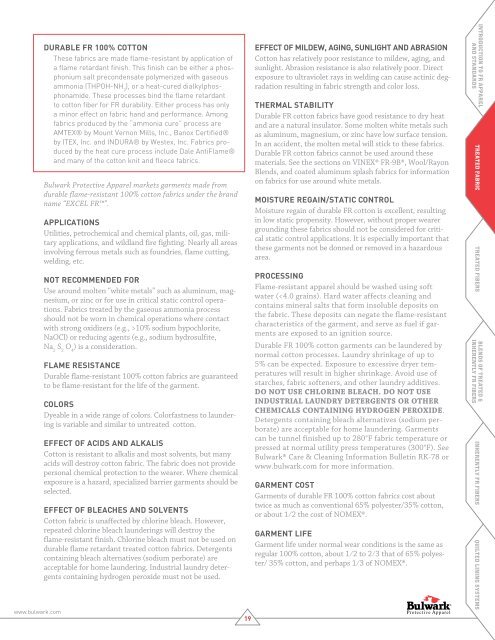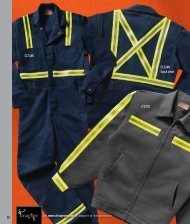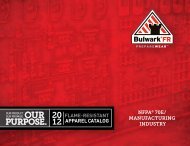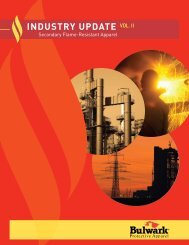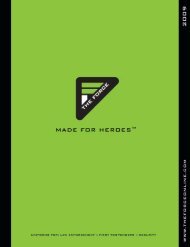VOL. 10 - Red Kap Work Clothes, Uniforms, & Coveralls
VOL. 10 - Red Kap Work Clothes, Uniforms, & Coveralls
VOL. 10 - Red Kap Work Clothes, Uniforms, & Coveralls
You also want an ePaper? Increase the reach of your titles
YUMPU automatically turns print PDFs into web optimized ePapers that Google loves.
www.bulwark.com<br />
Durable FR <strong>10</strong>0% Cotton<br />
These fabrics are made flame-resistant by application of<br />
a flame retardant finish. This finish can be either a phosphonium<br />
salt precondensate polymerized with gaseous<br />
ammonia (THPOH-NH 3<br />
), or a heat-cured dialkylphosphonamide.<br />
These processes bind the flame retardant<br />
to cotton fiber for FR durability. Either process has only<br />
a minor effect on fabric hand and performance. Among<br />
fabrics produced by the “ammonia cure” process are<br />
AMTEX® by Mount Vernon Mills, Inc., Banox Certified®<br />
by ITEX, Inc. and INDURA® by Westex, Inc. Fabrics produced<br />
by the heat cure process include Dale AntiFlame®<br />
and many of the cotton knit and fleece fabrics.<br />
Bulwark Protective Apparel markets garments made from<br />
durable flame-resistant <strong>10</strong>0% cotton fabrics under the brand<br />
name “EXCEL FR”.<br />
Applications<br />
Utilities, petrochemical and chemical plants, oil, gas, military<br />
applications, and wildland fire fighting. Nearly all areas<br />
involving ferrous metals such as foundries, flame cutting,<br />
welding, etc.<br />
Not Recommended For<br />
Use around molten “white metals” such as aluminum, magnesium,<br />
or zinc or for use in critical static control operations.<br />
Fabrics treated by the gaseous ammonia process<br />
should not be worn in chemical operations where contact<br />
with strong oxidizers (e.g., ><strong>10</strong>% sodium hypochlorite,<br />
NaOCl) or reducing agents (e.g., sodium hydrosulfite,<br />
Na 2<br />
S 2<br />
O 4<br />
) is a consideration.<br />
Flame Resistance<br />
Durable flame-resistant <strong>10</strong>0% cotton fabrics are guaranteed<br />
to be flame-resistant for the life of the garment.<br />
Colors<br />
Dyeable in a wide range of colors. Colorfastness to laundering<br />
is variable and similar to untreated cotton.<br />
Effect of Acids and Alkalis<br />
Cotton is resistant to alkalis and most solvents, but many<br />
acids will destroy cotton fabric. The fabric does not provide<br />
personal chemical protection to the wearer. Where chemical<br />
exposure is a hazard, specialized barrier garments should be<br />
selected.<br />
Effect of Bleaches and Solvents<br />
Cotton fabric is unaffected by chlorine bleach. However,<br />
repeated chlorine bleach launderings will destroy the<br />
flame-resistant finish. Chlorine bleach must not be used on<br />
durable flame retardant treated cotton fabrics. Detergents<br />
containing bleach alternatives (sodium perborate) are<br />
acceptable for home laundering. Industrial laundry detergents<br />
containing hydrogen peroxide must not be used.<br />
19<br />
Effect of Mildew, Aging, Sunlight and Abrasion<br />
Cotton has relatively poor resistance to mildew, aging, and<br />
sunlight. Abrasion resistance is also relatively poor. Direct<br />
exposure to ultraviolet rays in welding can cause actinic degradation<br />
resulting in fabric strength and color loss.<br />
Thermal Stability<br />
Durable FR cotton fabrics have good resistance to dry heat<br />
and are a natural insulator. Some molten white metals such<br />
as aluminum, magnesium, or zinc have low surface tension.<br />
In an accident, the molten metal will stick to these fabrics.<br />
Durable FR cotton fabrics cannot be used around these<br />
materials. See the sections on VINEX® FR-9B®, Wool/Rayon<br />
Blends, and coated aluminum splash fabrics for information<br />
on fabrics for use around white metals.<br />
Moisture Regain/Static Control<br />
Moisture regain of durable FR cotton is excellent, resulting<br />
in low static propensity. However, without proper wearer<br />
grounding these fabrics should not be considered for critical<br />
static control applications. It is especially important that<br />
these garments not be donned or removed in a hazardous<br />
area.<br />
Processing<br />
Flame-resistant apparel should be washed using soft<br />
water (


